2004 Mazda 6
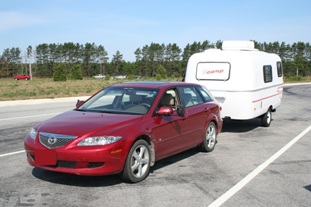
The first vehicle we used for pulling our Scamp was a 2004 Mazda 6 station wagon with a V6 3.0L Engine. One of the reasons we chose the Scamp was because the Mazda 6 was the largest vehicle that we had, and we were not sure how well it would handle pulling a camper. We used it to pull a slightly smaller trailer that we have for our SCA camping trips, but we only use that a few times a year. The Mazda 6 was quite capable, as we found out over the next few years, of pulling the Scamp through a wide variety of road conditions. We pulled it through the Rocky Mountains, through the Appalachian Mountains, through the desert, and across the Midwest through Missouri, Iowa, Wisconsin, and Minnesota. It is also nice knowing that we could pull it with the Mazda 6, unhook the Scamp, then return to the 25 MPG or better while touring the areas we were visiting. It is also nice to have a smaller vehicle to drive around in strange areas, rather than trying to drive a large tow vehicle around.
There are a few things that I want to point out. While the Mazda 6 does a wonderful job, we do pay attention to "towing detail". We made sure to weigh the tongue of the trailer each time before hooking up. I did not want to exceed 300 pounds of tongue weight on the car. Actually, I tried to keep it around 10% to 15% of the total weight of the Scamp. That helped it to follow the car much better. Also, when going up and down steep inclines, I paid close attention to the RPMs of the engine so the transmission would not be slamming into gears just to make it up hills. Lastly, I would always recommend an electric brake system for the car and trailer. Going through the Rocky Mountains it was nice to be able to adjust the brake pressure when going down hill. It prevented the trailer from pushing and over stressing the car's brake system. Also, the electric brake controller in the car has a panic button that you can use to apply the trailer brakes without applying the vehicle brakes. This comes in handy if the trailer starts to sway a bit more that it should.
The last couple of things I would like to point out concerns the trailer battery and the tongue weight of the camper. Since we used the seven prong connection for the trailer, we can charge the Scamp's battery from the car's engine while traveling down the road. But I would suggest that if you are going to stop for a longer period of time, you may want to consider disconnecting the trailer cable so you do not drain the car battery. Also, consider putting the front foot of the Scamp down and take the weight off of the hitch of the vehicle. I did not like going in the camper and adding my weight to the tongue weight on the car. Most of the time you are not going to hurt anything, but I figured why take the chance. Also, it makes walking in the trailer a bit more stable. I usually follow this routine when having dinner, shopping, or stopping at a rest stop for the night. If you do follow this advice, please make sure the trailer wiring connecter is reconnected and the foot raised before starting down the road again.
Below are a series of photos featuring the Scamp and the Mazda 6 as the tow vehicle.
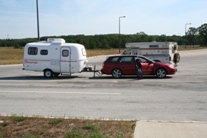
|
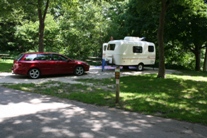
|
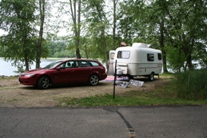
|
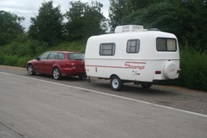
|
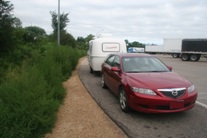
|
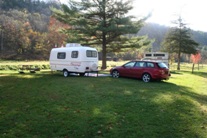
|
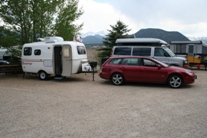
|

|

|
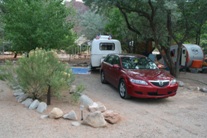
|
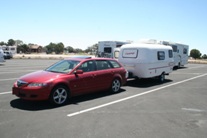
|
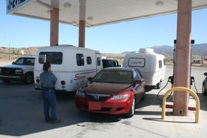
|

|
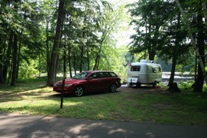
|
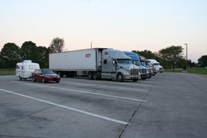
|
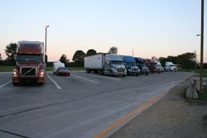
|
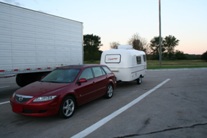
|
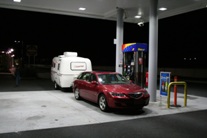
|

|
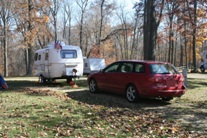
|
1988 Mazda B2200
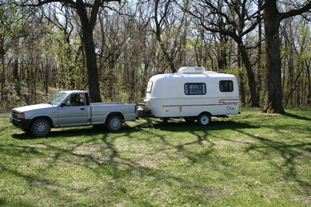
The other vehicle that we had at the time of the Scamp purchase was a 1988 Mazda B2200 2.2L four cylinder half ton pickup truck, with a manual transmission. Initially, we were thinking about using this as the primary tow vehicle, but at the time of purchase, the truck was showing its age, and it was not very roomy for a long trip. I decided that it would be better as a backup tow vehicle, or the tow vehicle for short trips. That way we could take the wear and tear off of the car. It worked really well for these purposes, but its age eventually caught up to it. In the late spring of 2013, we found that the frame had severe rust damage, as well as some dangerous fracturing, that could not be repaired. We ended up having to scrap it out a few months later.
During the four years or so that we did use it as a tow vehicle, it perform well. Most newer four cylinder trucks would not have much difficulty pulling any size of Scamp. If the Mazda truck had been a bit younger, I image that it would not have had any difficulty pulling the Scamp. As a matter of fact, the summer before we purchased our Scamp, we saw a Ford Ranger pulling a fifth wheel Scamp through a campground with very little effort, and the Rangers are not much different from the Mazdas. That is what prompted me to start looking at the Scamp brand of campers in the first place. Whatever vehicle you end up using, I would still recommend the electric brake system for the trailer and vehicle. It is much safer to have them when towing, and it really does help to have the trailer slow itself down, while taking the pressure off of the tow vehicle's brake system.
Below you will find a series of photos showing the various places that we used the Mazda truck as the tow vehicle. There are other photos we have were we used the Mazda to tow the canoe trailer, but I am primarily focusing on tow vehicles for Scamp trailers.

|
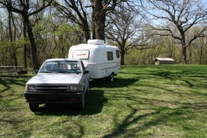
|
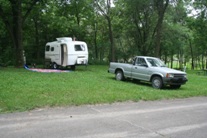
|
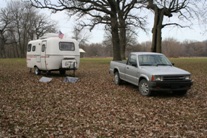
|
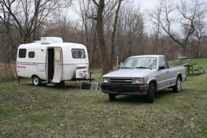
|

|
2008 Ford Explorer Sport Trac
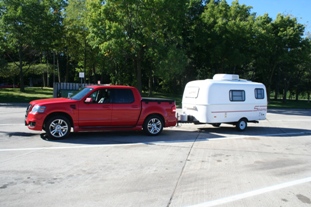
The current vehicle that we use as the primary towing vehicle is a 2008 Ford Explorer Sport Trac with a V6 4.0 Liter engine, automatic transmission, full towing package, and an automatic all wheel drive system. We picked this up in the early summer of 2013 when we learned of the condition of our Mazda truck. While I did not drive either of the trucks that we had much for everyday driving, they are nice to have when you have to haul larger items, or in this case campers and utility trailers. One of the drawbacks to our older Mazda truck was that it was only a two seat vehicle. With the Sport Trac, we get the room that we have with the Mazda 6, but this truck has a larger towing capacity, and bit larger storage area for cargo. One of the downsides to the Sport Trac is that the mileage is a bit less when towing and everyday travel, but not nearly as bad as a full size pickup truck. But on the upside, it is still small enough that it can be easy to maneuver on the road, and does not take up nearly as much room as a full size truck.
There are quite a few benefits to towing with this vehicle. First, it came with the towing package that will tow up to seven thousand pounds with a seven hundred pound tongue weight limit. While I still try to balance out the trailer for towing, the truck can handle the shifting weight of the trailer better than the car. Also, all of the wiring for pulling trailers came complete from the factory. This included the seven pin connector for the trailer, as well as a quick connect under the dash for the brake controller. Also, it has extra cooling capacity for the transmission during tow conditions, as well as having the ability to turn off the overdrive for steep road conditions. And lastly, it has a large enough battery and alternator, that charging the battery in the trailer is much easier on the truck's electrical system.
The Sport Trac also allows us to have an extended camping season. With the Mazda 6, I was concerned about having to pull through snow conditions. With the Sport Trac and its all wheel drive system, that is not as much of concern for us, and we have even considered a winter camping trip as well. Below you will see the series of photos showing the places and conditions that we have used the Sport Trac as a towing vehicle. And you will notice that we did use it in snow conditions, just not intentionally.

|

|
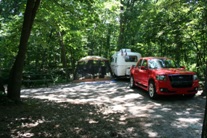
|

|
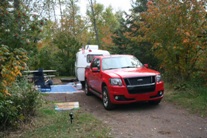
|
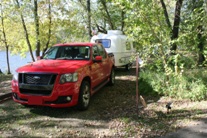
|

|
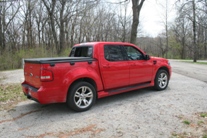
|
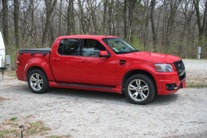
|

|

|

|
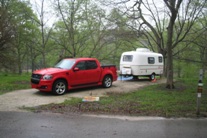
|
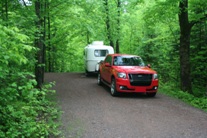
|
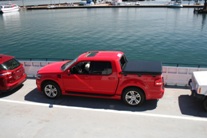
|
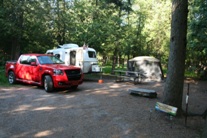
|
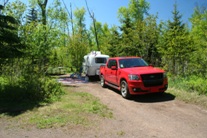
|
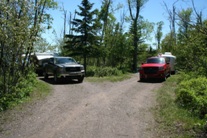
|

|
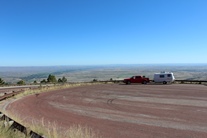
|
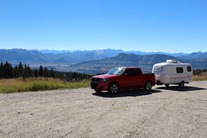
|
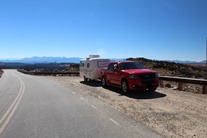
|

|

|

|
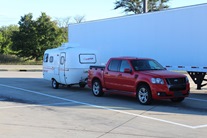
|

|

|

|

|
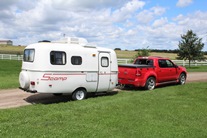
|
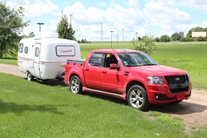
|
In closing, I would just like to say that Scamp trailers do offer a wider variety of choice when it comes to towing vehicles. Many small trailers, pop-ups, etc do require beefier vehicles for towing and the list of vehicles is much narrower. While I have focused primarily on vehicles towing Scamps, there are other Scamp like trailers out there that would fall into this category. So if you are not completely sold on Scamp, you do have a few other options in the light weight fiber glass camper market. If you have any questions regarding how we tow our Scamp, or about some of the topics discussed here, please feel free to contact us at information@dampenedenthusiasts.com or myself at russ@dampenedenthusiats.com.